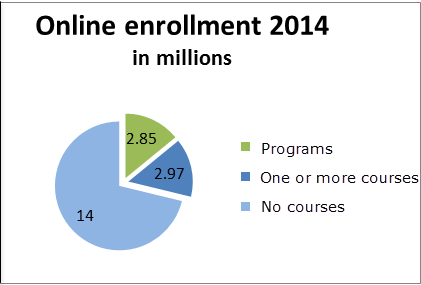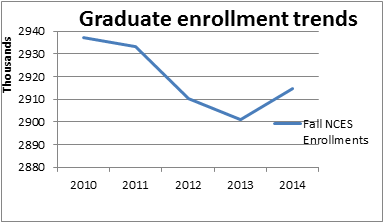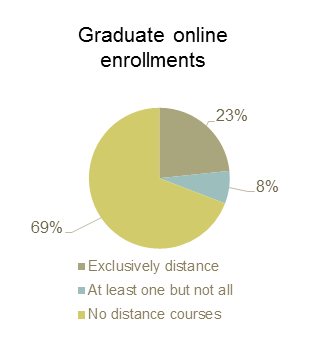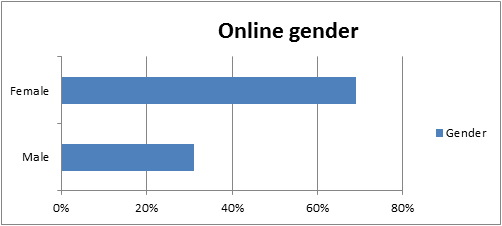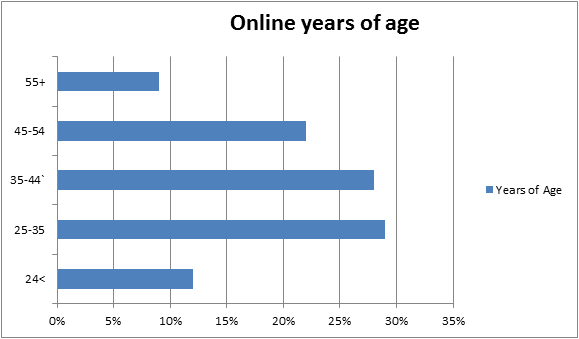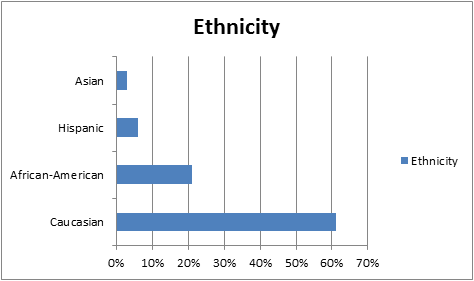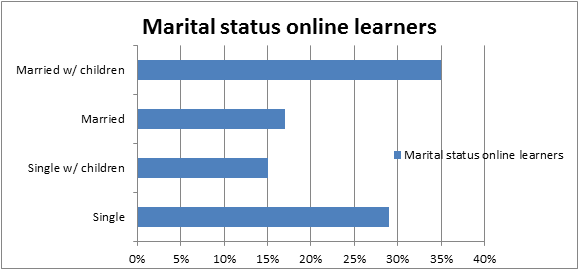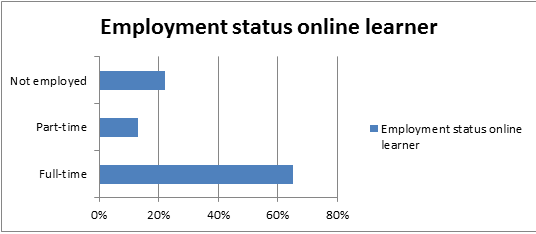enrollment
8 important facts on growing enrollment through online learning or graduate programs
Is your college considering adding online programs or graduate programs? If not, should you be? Based upon enrollment trends and future projections, the answer is YES. Traditional undergraduate programs will not bring growth to a campus. Diversifying with both online delivery and graduate programs holds a stronger promise of growth.
To explore this opportunity further, consider the following eight facts drawn from the latest available reports of Babson Survey Research Group, the National Center for Education Statistics (NCES), and Ruffalo Noel Levitz.
FACT #1: Despite an overall enrollment decline in higher education, we continue to see modest growth in the number of students who choose to complete courses and entire degree programs via online delivery. Of the 20,207,360 college students enrolled in fall 2014, 5.8 million (28.8 percent) pursued coursework through online delivery formats. That’s an increase of 2.8 percent over fall 2012’s online percentage of 26 percent.
Clearly, if your college has not implemented online courses and programs, you are failing to meet the needs of a growing number of learners. When enrollments from traditional delivery methods slip, turning to alternative delivery modalities makes sense. Students now seek entire degree programs which are offered online. We’ll understand why a little later in this blog as we look at the demographic of this learner.
FACT #2: While online enrollments have grown, graduate enrollments are also experiencing a rebound following a five-year decline from an all-time high of 2,937,011 in 2010:
FACT #3: Graduate students represent a high percentage of the total number of students pursuing courses and programs online. In the fall of 2013, a total of 30.8 percent of all graduate students enrolled in online courses, consisting of 23 percent who pursued their entire programs online and 8 percent who enrolled in at least one online course:
FACT #4: When you move your programs and courses into an online delivery modality, you are able to attract a different type of learner. These learners are most likely to be female, in their mid 20s to mid 50s, married or single with children, Caucasian and African American, study fully online, work full-time, and be enrolled full-time. Based upon national demographics collected by Ruffalo Noel Levitz on over 118,000 students using our Priorities Survey for Online Learners we also know this about the characteristics of the online learner:
- Gender: 69% female; 31% male
- Age: 12% are 24 and under; 29% are 25-34; 28% are 35-44; 22% are 45-54; and 9% are 55 and over
- Ethnicity: 61% Caucasian; 21% African-American; 6% Hispanic; 3% Asian
- Marital status: 29% single; 15% single with children; 17% married; 35% married with children
- Employment: 65% full-time; 13% part-time; 22% not employed
FACT #5: Attracting and retaining this type of learner requires a far different approach than that used for a freshman-based population. This learner will conduct their own research, relying on these sources of information:
- Website (ensure there is an online tab on your homepage to attract these students)
- Catalog (online)
- Recommendation from instructor or program advisor
- College representatives
- Contact with current students and/or recent graduates of the program
- Catalog and brochures (printed)
- Advertisements
FACT #6: These learners typically consider enrolling for quite some time before they take any action, such as completing an information request or application. Once they have taken action, it signals an important step for them and they move quickly to enroll. When asked how long it took to start classes after submitting an application, studies indicate that 67 percent of online applicants begin classes within eight weeks.
It is important to respond quickly, within a day. This learner has raised their hand, and now wants to connect with you! Phone attempts are rated as most effective by colleges offering adult programs. By reaching the prospect voice-to-voice, an experienced enrollment advisor can uncover the primary barriers to enrollment the student may face – be they situational, institutional, or dispositional.
FACT #7: The online learner doesn’t select your institution because of your dormitories, campus, activities, food service, football team, or even your superb faculty. This learner is different. Consider these factors which were considered a priority for online learners in their decision to enroll:
- Convenience
- Flexible pacing for completing a program
- Work schedule
- Program requirements
- Reputation of the institution
- Cost
- Financial assistance available
- (tie) Future employment opportunities
- (tie) Ability to transfer credits
- Distance from campus
- Recommendations from employer
FACT #8: The online learner is typically attracted to a specific program. Online adult learners, graduate and undergraduate, typically have identified the program of study they seek. Business administration is consistently a number one choice for the online graduate learner, followed by nursing, computer science, and engineering. While we like to think of our online programs in a national sense, the majority of students are less than 100 miles from our campuses, so it is important to conduct appropriate market research when considering expansion of programs via online delivery.
Please contact my colleague, Whitney Larimer, at 800.876.1117 or email if you are interested in learning more about implementing online programs. There are many moving parts to consider, from choosing the learning management system, developing a marketing and enrollment strategy, gaining regional accreditation approval, and empowering faculty. Ruffalo Noel Levitz offers consulting services to help you walk through these challenges at both the undergraduate and graduate levels.
